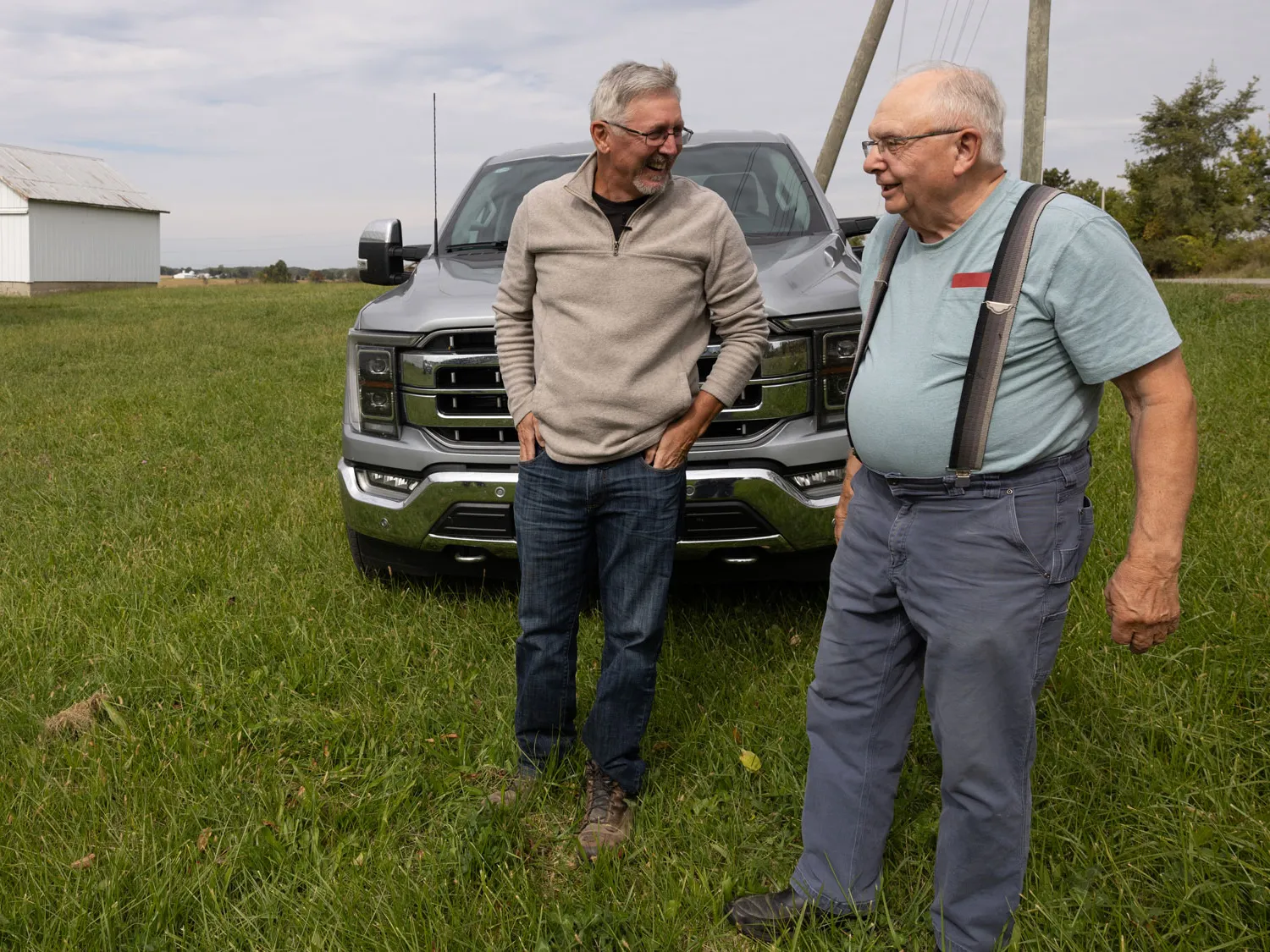Their mission: Rescuing old Ohio barns
Old barns falling in on themselves aren’t kindling in the eyes of Doug Morgan ’82 JD. They’re relics crafted with care and deserving of new life.
Stories by Erin MacLellan | Photos by Jodi Miller
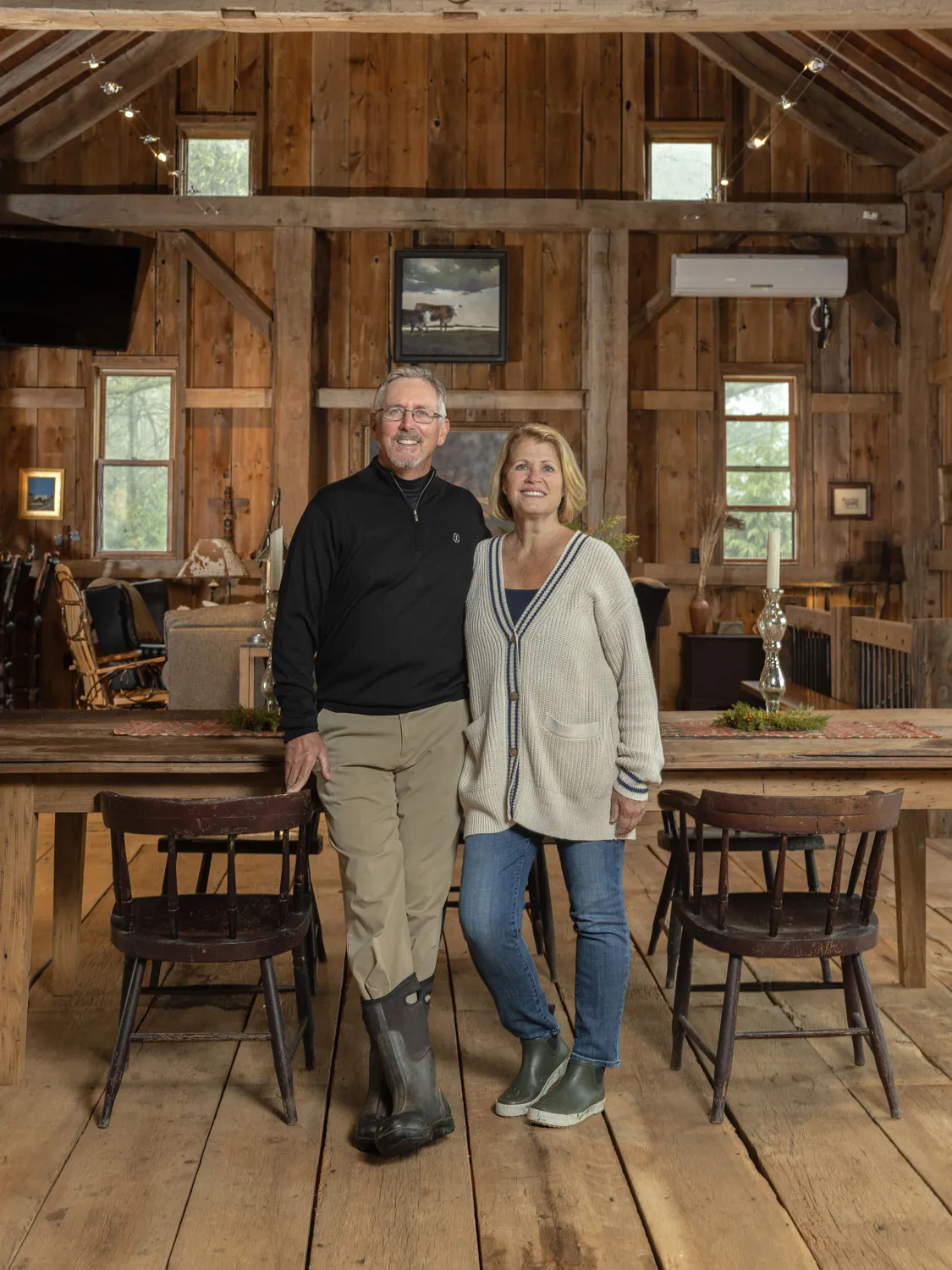
Doug and Beth Morgan visit “Kate’s Barn,” which he reconstructed on family property near Mount Vernon to host their daughter’s wedding.
It was just another old barn falling down along Route 13 in rural Ohio.
Drivers whizzing by, if they noticed it at all, might assume the barn near Utica was destined for a fire pile. But Doug Morgan ’82 JD saw something else in the 1830 timber frame. He saw possibilities. A new home. A wedding venue. A gathering place for families and friends.
Stepping inside the old barn one day in 2022, Morgan admired the massive hand-hewed beams carved from virgin forests that once covered Ohio. He marveled at the cathedral-like rafters, which soared to 23 feet. Touching the weathered sycamore timbers, the onetime history major could almost reach back 200 years, to the people who built Ohio’s barns from what he considers some of the finest timber in the world.
Morgan knew he’d buy this barn. And he’d find a new home for it.
“I believe we need to save as many barns as we can so our kids and grandkids can appreciate the amazing first-growth forest we had in Ohio and admire the work of the craftsmen who built these hand-hewn timber frames,” he says. “It’s a calling I have — to rescue historic barns and give them a new life.”
A dozen years ago, Morgan — then in his mid-50s — left a successful law career and started a new life for himself.
Together with his wife, Beth Morgan ’79, he founded Mount Vernon Barn Co., to restore historic barns and log houses and transform them into homes, community centers, event spaces and wedding venues.
“These barns are vernacular works of art,” says Morgan, who lives in Columbus. “They’re like handmade sculptures — no two timbers are alike. But they are obsolete for modern farming. As a result, they’re disappearing in Ohio. I want to save these barns by making them useful for the 21st century.”
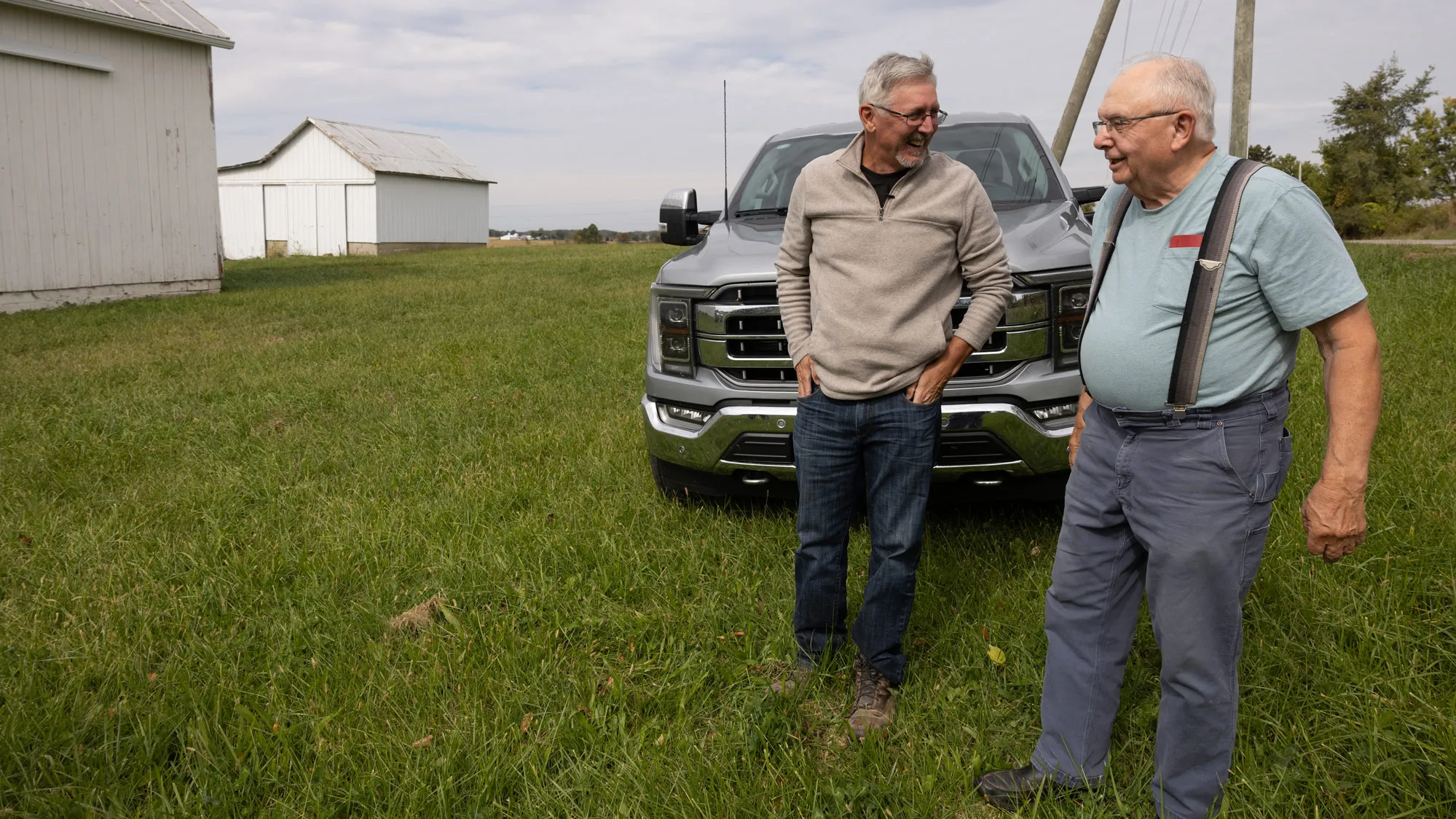
Doug loves hearing the history of the old barns he reclaims for new life. Here, he talks with Larry Layman ’66 about a barn in Galion, Ohio, that Doug is considering moving and refurbishing.
Morgan’s quest takes him all over the backroads of Ohio scouting for barns and other historical buildings. He set a goal to repurpose 100 structures — and with 90 completed, he’s almost there. His meticulous work drew the attention of “Restoration Road,” a popular Magnolia Network show that featured two of Morgan’s projects, giving national exposure to the work.
Morgan became so busy that Beth stepped up to manage things. She is chief financial officer of the five businesses they own, which also include a distillery, restaurant, event venue and Airbnbs.
Historic preservationist and daring entrepreneur are unlikely paths for a former corporate lawyer who practiced on Wall Street and in Columbus for years. Even architect Jeff Ashmore ’87, who works with Morgan on barn restorations, couldn’t have guessed his former neighbor’s future.
“We grew up in Clintonville, and I was friends with Doug’s younger brother,” Ashmore says. “We’d all sneak into apartment complex pools in the summer, and Doug would sit by the pool, reading books. I asked his brother, ‘What’s wrong with Doug? Why is he reading instead of swimming?’ And his brother said, ‘Oh, he goes to Harvard.’ It made no sense to me.”
It made sense to Morgan, who excelled as a history major at Harvard University and set his sights on law school. Hitting the books paid off. After earning his JD from Ohio State’s Moritz College of Law, he built a successful career specializing in mergers and acquisitions.


Doug checks the progress of bourbon that guests can sample when they visit the mill complex in the heart of Utica.
Previous photo: Beth tidies up a vacation rental that came to life when they restored an old mill in Utica, Ohio. Their Mill Street Grains and Gatherings also includes event space and a small-batch distillery.
But sitting behind a desk all day was hard for a man with stores of energy and a desire to work with his hands. He decided to pursue a weekend project, an ambitious one, and bought an 1820s log cabin that he moved to land he and Beth own near Mount Vernon.
“I didn’t have experience other than a woodworking class in junior high school, so I contacted the Knox County Historical Society and asked if they knew anyone who restored old log cabins,” Morgan says. “They introduced me to a gentleman named Richard Morey, who became like my second father.”
Under Morey’s mentorship, and with the assistance of Amish craftsmen he hired, Morgan restored two log cabins and three barns while still practicing law.
“It was 20 years of weekends,” Morgan says of his early restoration projects.
By 2011, with the Morgans’ three kids almost through college, Doug decided to change course. He enjoyed the law, but he loved historic barns more. Time was racing by — he was 55 years old — and barns were quickly disappearing from Ohio’s landscape.
Decision made, Doug took Beth to dinner and told her he’d quit his job.
“I said, ‘Ha, ha, very funny,’” Beth remembers. “And he says, ‘No, I’m serious. I want to do this barn thing full-time.’ I was taken aback, but you have to know Doug, and you have to choose your battles. I knew I couldn’t win that one.”
Yes, Beth knew Doug well. They met in first grade in Clintonville, dated in high school and married after finishing college. Now, they were embarking on a new adventure.
Among their first projects: restoring a 200-year-old barn for relocation at Columbus’ Franklin Park Conservatory and refurbishing a 120-year-old structure to grace the grounds of the Ohio Wildlife Center in Powell. Both structures are used for educational activities and special events such as weddings and banquets.
Closer to home, Morgan renovated a nearly 200-year-old barn and situated it on family property near Mount Vernon to host daughter Kate’s wedding.
“People began asking if they could rent Kate’s Barn [as it’s come to be known], but Beth and I have a lot of personal things in there, and we wanted it for family gatherings,” Morgan says. “It gave me the idea to look for a venue in a historic setting that Beth and I could run.”
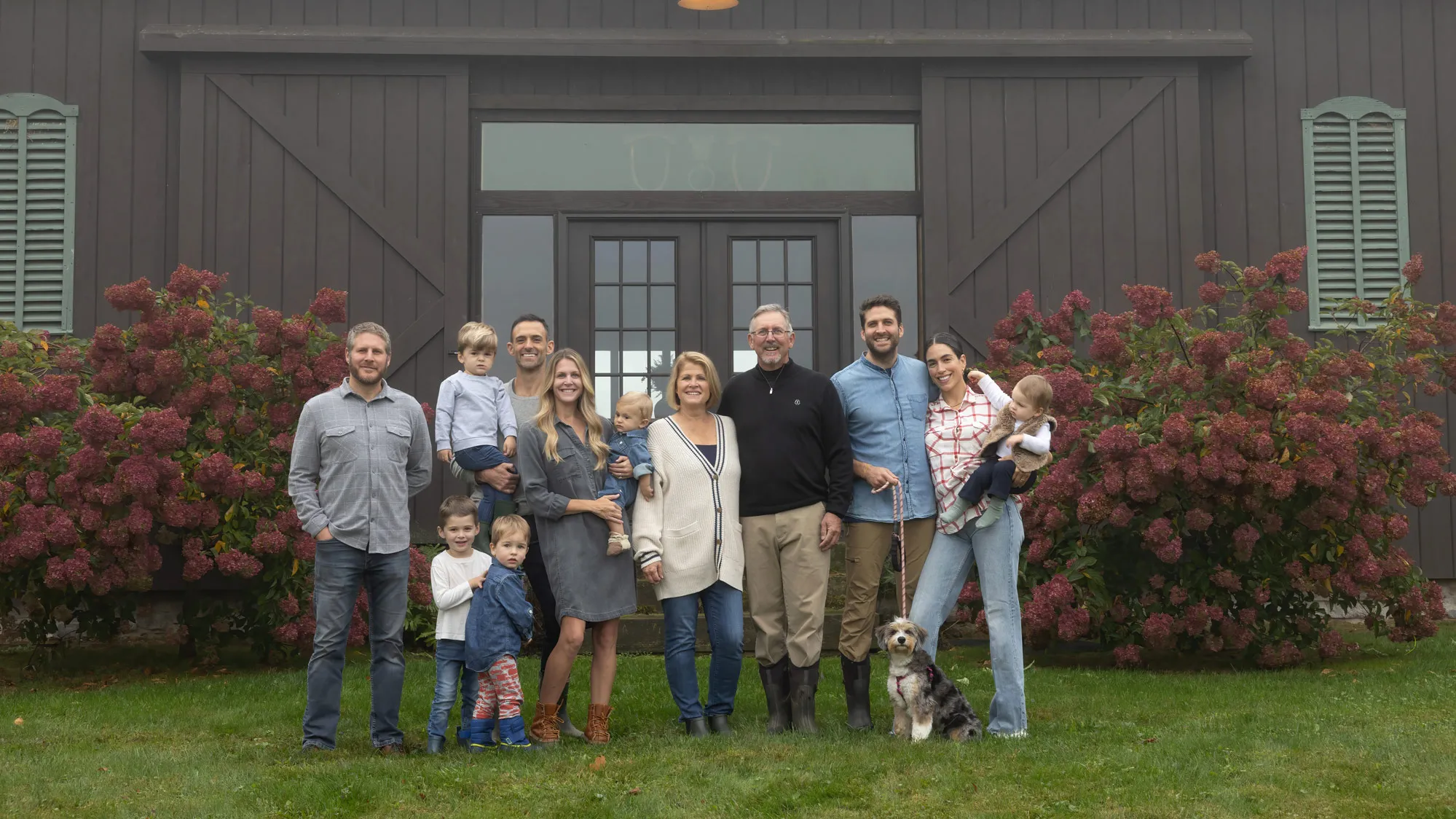
The Morgans pause for a family photo in front of “Kate’s Barn” on a foggy October morning.
He found it in Utica, on land where an 1815 grist mill once stood. That mill later was replaced by the Campbell Mill, which served local farmers needing to grind and store their grain. Long ago abandoned, the 70-foot-tall mill stood sentinel over Utica. While prowling the property, Morgan discovered three 19th-century buildings, one a former distillery. Ideas popped into his head; a vision took shape.
“Doug took me to the top floor of the mill and said, ‘This is going to be a two-story Airbnb,’” Beth says. “I looked around and saw pigeon poop everywhere. It was a disaster. I said, ‘No way.’ But this is how Doug Morgan works. You don’t even question it because it will turn out even better than you ever dreamed.”
Three years later, Mill Street Grains and Gatherings features a wedding venue for 225 guests, a luxurious vacation rental and a small-batch distillery. Beth oversees the weddings, and guests can sample brandies and bourbons from the distillery. Once a month, Morgan travels to Kentucky to distill a batch of whiskey from an age-old recipe.
Even as Morgan juggles multiple projects, he doesn’t forget what he’s pledged to do.
A year ago, he’d vowed to find a new use for that sycamore barn falling down along Route 13. In the months that followed, Morgan sold it to Kari Lindberg, a retired Columbus firefighter with a dream of her own: to transform a historic barn into a gathering place for family and friends.
Morgan hired his Amish friends to dismantle the structure, then reassemble it on land Lindberg owns in Delaware County, Ohio.
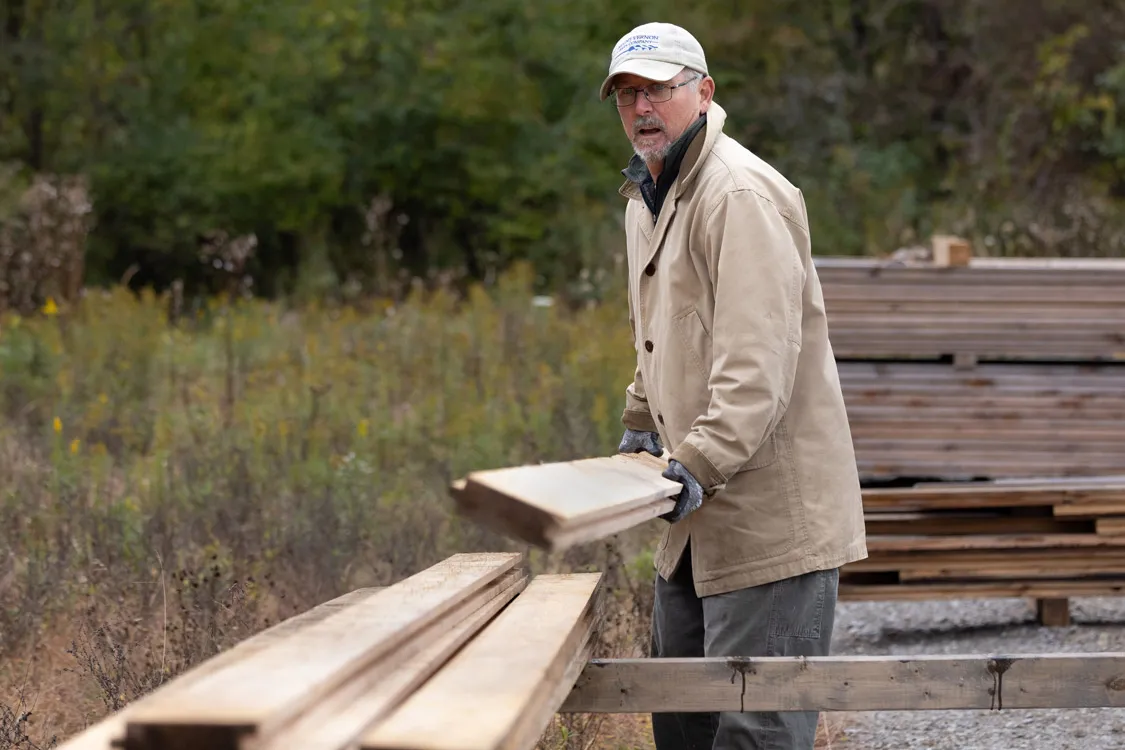
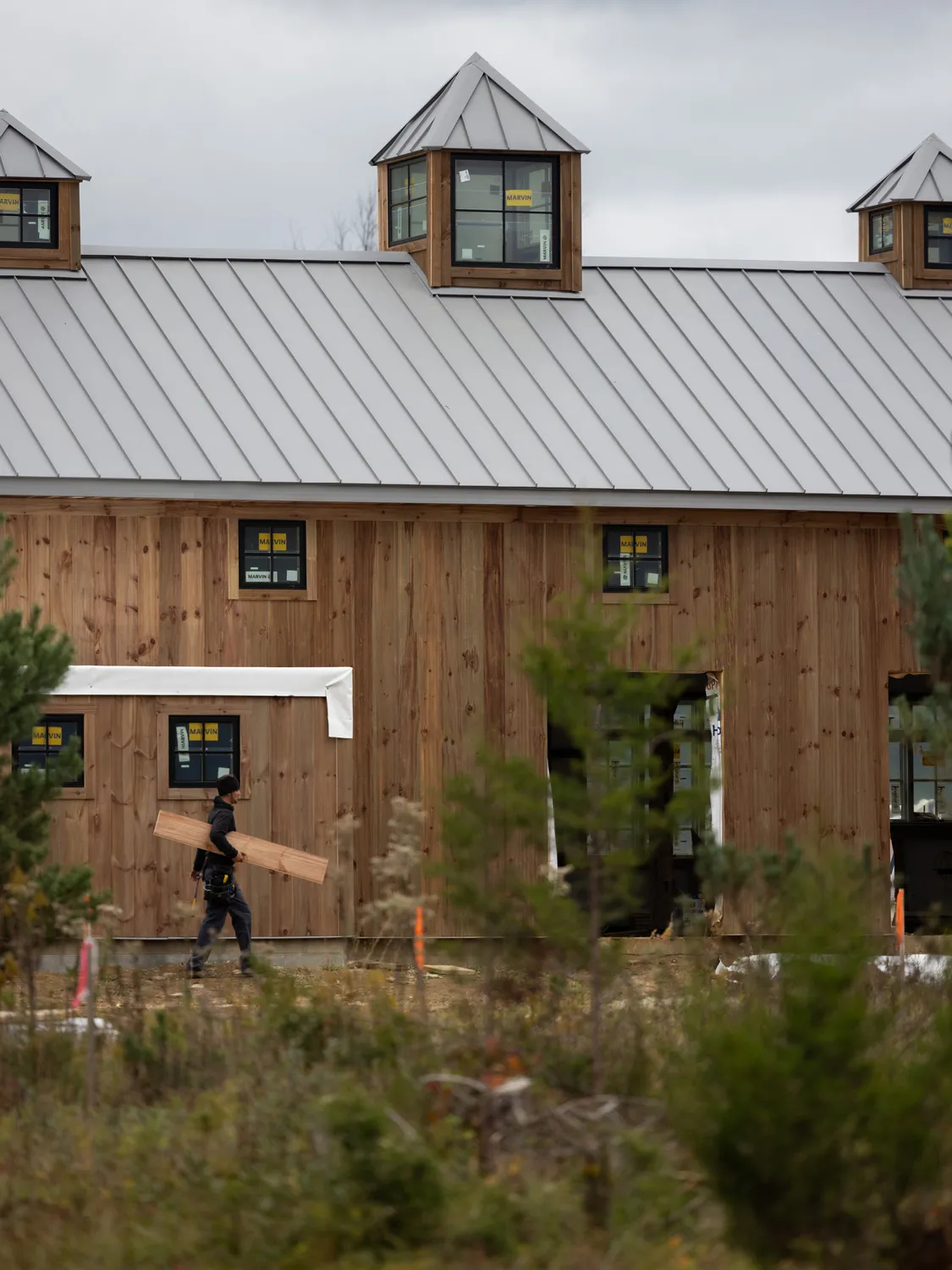
Progress continues on a reclaimed barn in the Lindberg family’s Delaware County “agrihood.” The property will include homes, room to grow food, gathering spaces and more.
Previous photo: Doug moves boards due for staining. Ohio barn builders of the 19th century often used trees that soared to 200 feet tall.
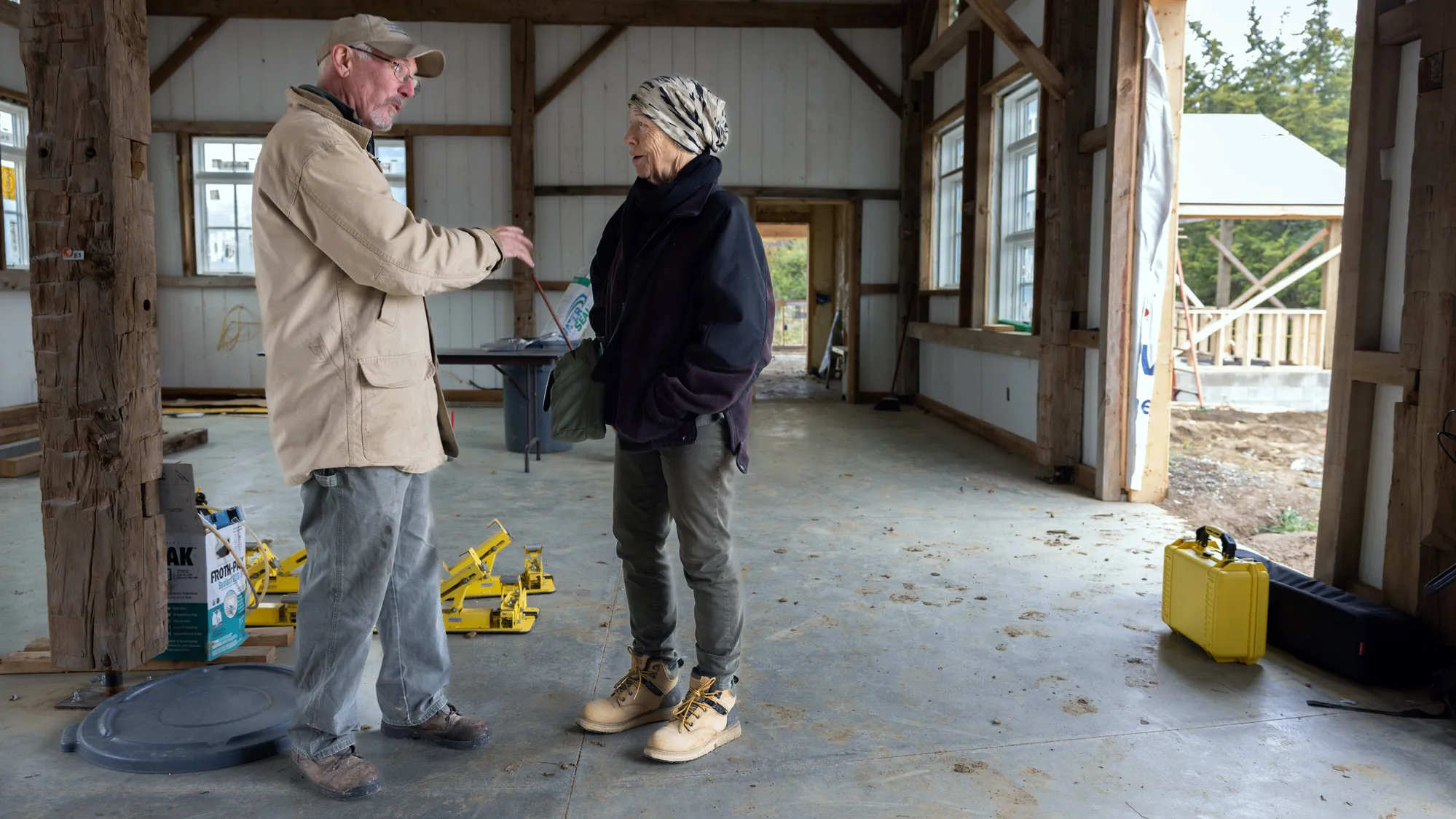
Doug shares an update on the refurbished barn with Kari Lindberg.
One cool day this fall, amid the drone of drills, Morgan and Lindberg huddled inside the barn to survey the progress. It takes only a day to re-erect a barn, but modernizing it requires several months.
“It’s just so beautiful,” Lindberg says. “I can’t wait for it to be done.”
The barn boasts new windows and doors, insulated walls and heated floors to provide the comforts of modern life and space for a kitchen, loft, craft room and cozy spots for loved ones to gather.
The barn is the centerpiece of a compound that Lindberg and sisters Lisa and Nora Lindberg ’75 are building near Alum Creek Reservoir. The “agrihood” will include six homes, a greenhouse and a 2-acre garden. It represents a homecoming for Lindberg, who spent her childhood nearby with her four siblings and late parents, educator Charisma Madson Lindberg ’60, ’68 MS, ’73 PhD and minister Harold Lindberg.
“We had to move away in the 1970s because they flooded the land for Alum Creek [Reservoir],” Lindberg says. “We all scattered to the wind, but as we got older, my sisters and I started talking about moving back.”
Lindberg’s architect, Ashmore, directed her to Morgan when she began searching for a barn. “I knew Doug was the right person,” Lindberg says. “He’s very kind, and he understands the community my sisters and I want to create here.”
Morgan is quite impressed with the Lindberg sisters’ vision. “I’m very honored that Kari and her sisters trusted me with this project. It’s an incredible family story.”
Family stories — Lindberg hopes folks will share many of them when they gather in this special place around a 10-foot table Morgan is building for them. Always eager to give old things new life, he saved floor planks from the barn for the table.
And project by project, Morgan is adding to his own family story. On the day of the Lindberg barn raising, he invited his three children, Brandon ’18 MSW, Kate Morgan-Kocher and Corey ’13, ’13, and five grandchildren to attend.
Each grandchild perched upon a piece of timber Morgan had cut from leftover barnwood just for them. They had a front-row seat to watch their “G-Pop” and his crew hoist the barn into place.
“I have a photo of them that day,” Morgan says. “It will be an amazing piece of our history.”
X
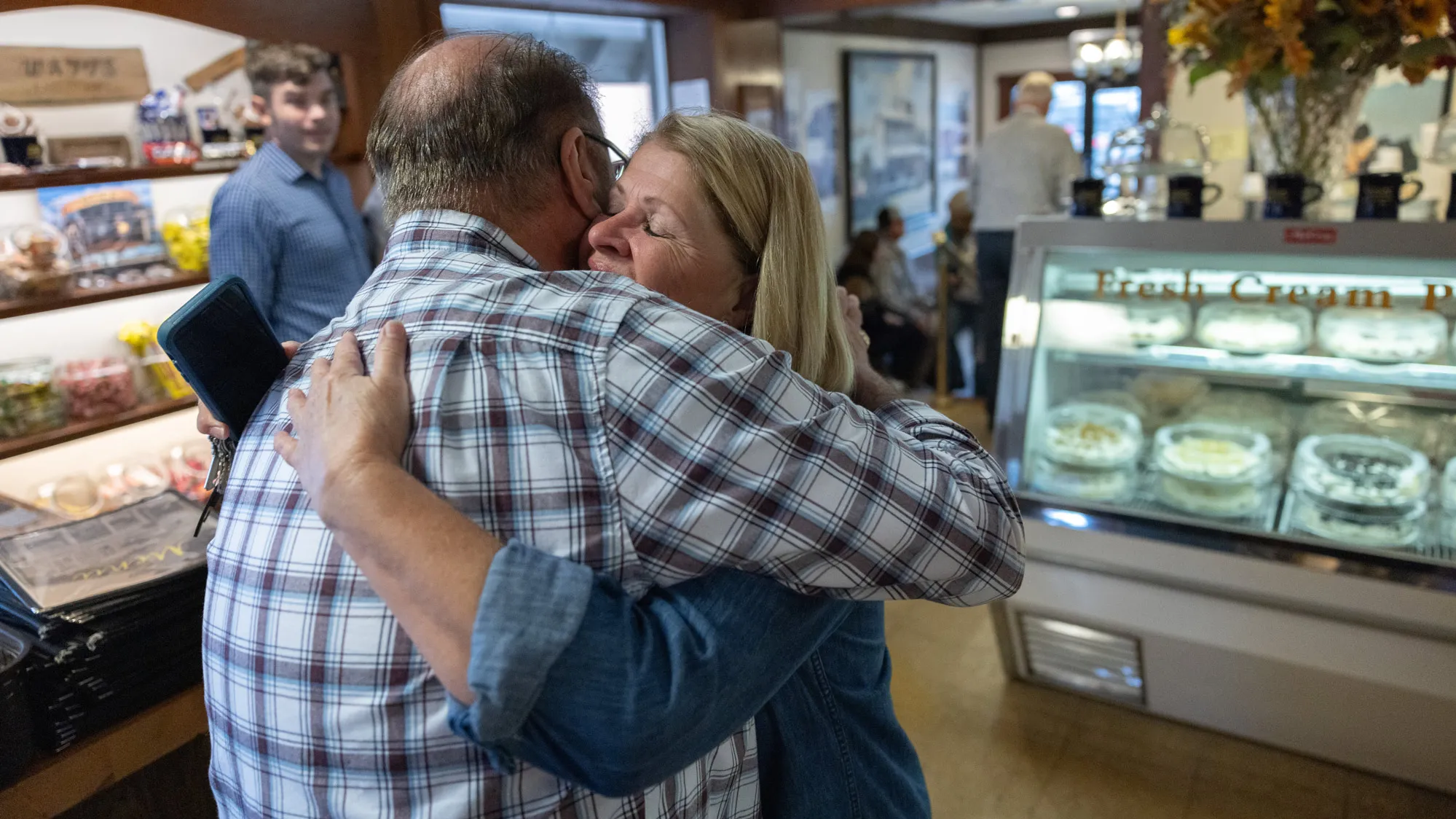
Beth Morgan hugs former Watts Restaurant owner Roger McCoy, who loves to pitch in by plating desserts, his specialty.
Comfort in tradition: Preserving a storied eatery
He came into Watts Restaurant to buy freshly made pies — 10 or 20 a week in raspberry, coconut cream, butterscotch, apple — until one day, he left as the new owner of the 111-year-old community gathering place.
Watts was an unexpected purchase for Doug Morgan, who’d never worked in a restaurant and certainly never intended to run one. Did fresh peach pie cinch the deal? No, it was history, pure and simple.
Morgan loves history, and he had one with this homey restaurant in the village of Utica.
As a teenager, he dined at Watts with Beth, now his wife, and her parents while on Sunday drives in the country. An old mill brought him back to Utica in 2019, when he began restoring Campbell Mill, across the street from Watts.
Restaurant manager Andrew Wiechart says Morgan stepped up his patronage during the pandemic, when business dropped drastically.
“He’d buy pies for his family and friends, and we got to know him pretty well,” Wiechart says. “When the owners had to sell the business due to health problems, they approached Doug about buying it.”
Morgan views the purchase of one of Ohio’s longest-serving restaurants as aligning with the historic preservation mission he and Beth share: “This is a piece of Ohio history. We feel privileged to be the stewards of this business right now.”
Many locals frequent Watts, which was owned by the same family for more than 100 years. Others travel from miles away, visiting the eatery in tandem with stops at Utica’s orchards or the home base of Velvet Ice Cream. The restaurant seats 185 people in three dining rooms, where vintage wallpaper, gold-framed mirrors and local artists’ paintings adorn the walls.

Doug Morgan delivers drinks to Watts customers on a fall Sunday, when he works an afternoon shift each week.
The restaurant is especially busy on Sundays, when Morgan works an afternoon shift. “I bus tables, run the cash register, make coleslaw, whatever’s needed,” he says.
On a recent Sunday, customer Rebecca Phipps sat down at a booth while Morgan poured her coffee and set silverware on her table. She’d come for the fried chicken and pickled beets. “I like the atmosphere here,” she says. “It’s down-home, and there’s a sense of community.”
Server Bridgette Booth freshened up Phipps’ coffee. It’s her goal to treat customers like family.
“I’ve been coming to Watts since I was 4 years old,” says Booth, now 32. “My grandmother was a waitress here, and my mother worked in the kitchen. I used to come here after school and eat my favorite thing, chicken legs and mashed potatoes.”
Over the years, the menu has stayed much the same. Customers order comfort food like roast beef with mashed potatoes and dressing. They can choose from 25 desserts. Watts’ bakers whip up cream pies, while a local Amish bakery makes the other desserts.
Morgan says it’s not just the food that charms him, it’s Watts’ architectural history. The restaurant occupies three 19th-century buildings, including a Federal-style house built in 1820. The house has a cellar that the Watts staff used for storage.
No one had dared dig deep into the dank, dark space until Morgan arrived. One day, he was clearing piles of junk from the basement and made a discovery.
“We found a beehive oven and cooking fireplace that had been plastered over,” Morgan says. The dome-shaped oven dated back to the early 1800s and hadn’t been used in decades. He examined the basement’s sturdy walls and flooring, made of sandstone and brick, and began to envision a new use for the space: a gift shop for Watts’ customers and the community.
Morgan contacted a local quilter and asked if she’d like to sell fabric and quilting supplies there. She readily agreed. He found local artists eager to sell their works in the shop. Morgan and a crew got busy, and in late October, the 200-year-old building welcomed its newest tenant: Beehive Quiltery and Gift Shop.

Katie Paulson Silcott ’02, ’10 MA shares with middle schoolers the power of music to build confidence and unite people.

The Thompsons have braved a fraught path to delve into Earth’s climate history and prepare future scientists.

Keep your eye on Charles Muse ’13, a rising star in automotive engineering and an embodiment of Ohio State’s pay forward spirit.
